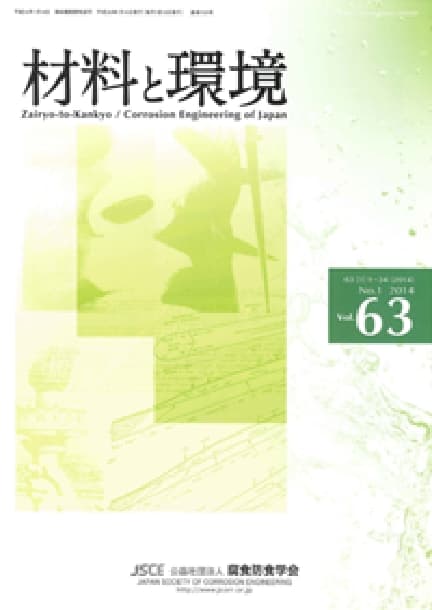- TOP
- Zairyo-to-Kankyo
- Vol. 58 (2009), No. 2
Zairyo-to-Kankyo Vol. 58 (2009), No. 2
Backnumber
-
Vol. 74 (2025)
-
Vol. 73 (2024)
-
Vol. 72 (2023)
-
Vol. 71 (2022)
-
Vol. 70 (2021)
-
Vol. 69 (2020)
-
Vol. 68 (2019)
-
Vol. 67 (2018)
-
Vol. 66 (2017)
-
Vol. 65 (2016)
-
Vol. 64 (2015)
-
Vol. 63 (2014)
-
Vol. 62 (2013)
-
Vol. 61 (2012)
-
Vol. 60 (2011)
-
Vol. 59 (2010)
-
Vol. 58 (2009)
-
Vol. 57 (2008)
-
Vol. 56 (2007)
-
Vol. 55 (2006)
-
Vol. 54 (2005)
-
Vol. 53 (2004)
-
Vol. 52 (2003)
-
Vol. 51 (2002)
-
Vol. 50 (2001)
-
Vol. 49 (2000)
-
Vol. 48 (1999)
-
Vol. 47 (1998)
-
Vol. 46 (1997)
-
Vol. 45 (1996)
-
Vol. 44 (1995)
-
Vol. 43 (1994)
-
Vol. 42 (1993)
-
Vol. 41 (1992)
-
Vol. 40 (1991)
Keyword Ranking
15 Dec. (Last 30 Days)
Zairyo-to-Kankyo Vol. 58 (2009), No. 2
The Prediction of Materials Failure and the Possibility of a Unified Failure Mechanism
Rokuro Nishimura
pp. 44-49
DOI:
10.3323/jcorr.58.44Abstract
First of all, this paper describes whether or not a parameter for predicting time to failure exists on three different methods (constant load, constant strain and SSRT). In the following section, a criterion for evaluation of failure susceptibility is discussed for the constant load method. Finally, to explain the results obtained experimentally for austenitic stainless steels and pure titanium, the new mechanisms of stress corrosion cracking and hydrogen embrittlement are proposed with the unified concept and aspect
Quartz Crystal Microbalance (QCM) Study of Corrosion Behavior of Silver and Simple Corrosion Test using Sulfur Vapor
Lisa Aoki, Keishin Osaka, Masataka Omoda, Jun’ichi Sakai, Yuichi Ishikawa
pp. 56-63
DOI:
10.3323/jcorr.58.56Abstract
Quartz Crystal Microbalance (QCM) technique was employed to continuously detect extremely small mass changes during corrosion of silver by sulfur vapor originated from sulfur flower as a function of temperature, RH and distance from sulfur to the silver surface. Corrosion progressed linearly with exposure time during all the tests. The corrosion rate increased as temperature rose, while no significant dependence on RH was observed. Furthermore the corrosion rate decreased markedly with increasing distance. This suggests that diffusion of sulfur vapor to the silver controls initial sulfide formation of silver.
These results have led us to propose a simple corrosion test using sulfur vapor to simulate corrosion of silver during indoor exposure of electronic equipment. The test employs the two distinct characteristics of sulfur vapor test using sulfur flower. Firstly the vapor pressure of sulfur by sulfur flower varies widely with temperature resulting a wide range of sulfur concentration. Secondly the corrosion rate of silver in sulfur vapor can be controlled by varying the distance between the sulfur flower and the silver surface.
Since the corrosion by sulfur vapor follows the linear kinetics similar to those found in practice as well as to provide identical major corrosion chemistry and morphology of the corrosion product, silver sulfide as in practice, we propose it to provide a reasonably reproducible, more flexible test which is much easier to handle in the laboratory than flowing multi-component gas mixtures containing hydrogen sulfide.
Corrosion Resistance of Composite Coating of Thermal Sprayed Metal and Painting against Atmospheric Corrosion
Hironobu Nuriya, Mitsugu Shima, Kazuo Ishikawa, Tsuguo Suzuki, Yoshiharu Kitamura
pp. 64-70
DOI:
10.3323/jcorr.58.64Abstract
The corrosion resistance of the composite coatings of thermal sprayed Zn, Zn-Al alloys and Al, with a simplified painting of the polyurethane resin, exposed to the atmosphere for 12 years in Sapporo and Tokyo was evaluated by the electric insulation test, the SEM observation and the EPMA. In spite of losing the electric insulation already, the simplified painting showed an excellent resistivity comparing to a conventional multi-layer painting. The diffusion of the iron through the sprayed Zn was larger than that through the sprayed Al, while the amounts of chloride and sulfur penetrating through the painting on the sprayed Al was larger than those on the sprayed Zn. This suggests that the thermal sprayed Zn layer has a tendency of the cation selective permeability. The protection at the scratched portion on the composite film seemed to be obtained by the cathodic protection in Zn, and the plug effect with the oxide in Al. Corrosivity of the atmosphere caused by chloride and sulfur was larger at Sapporo than at Tokyo. The fact suggests that the influence of the airborne salinity and the pollution substances is severe at the coast of Japan Sea, especially in a long period of the snow falling season.
Article Access Ranking
15 Dec. (Last 30 Days)
-
Delayed Fracture Mechanism of 1700 MPa-Class Quenched and Tempered Bolt under Atmospheric Corrosion Environment
Tetsu-to-Hagané Advance Publication
-
Perspectives on the Promising Pathways to Zero Carbon Emissions in the Steel Industry toward 2050
ISIJ International Vol.65(2025), No.2
-
Effect of B on Surface Oxidation Behavior and Phosphatability of Si-Mn-added Cold-Rolled Steel Sheets
ISIJ International Advance Publication
-
Factors Influencing the Bonding Phase Structure of Iron Ore Sinters
ISIJ International Vol.43(2003), No.9
-
Effect of microstructural heterogeneity on fatigue limit of as-quenched low-carbon low-alloy martensitic steel
ISIJ International Advance Publication
-
Prussian blue as a fully reversible hydrogenochromic material for visualizing hydrogen distribution in Fe sheet
ISIJ International Advance Publication
-
Progress of Strip Casting Technology for Steel; Historical Developments
ISIJ International Vol.52(2012), No.12
-
Research Progress on Optimal Blending of Iron Ore Powders for Sintering
ISIJ International Vol.65(2025), No.12
-
-
Microstructures and Reduction Properties of High CaO Concentration Sintered Ore
ISIJ International Advance Publication
You can use this feature after you logged into the site.
Please click the button below.










